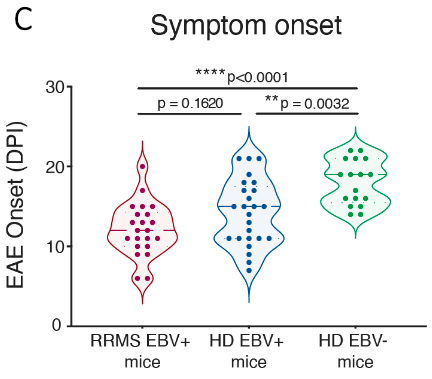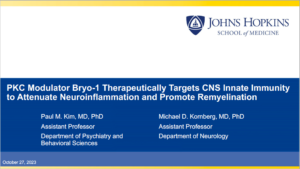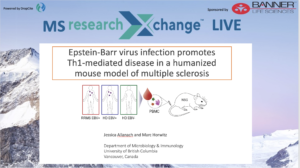
After presenting their research at our most recent MS researchXchange Live Event, Jessica Allanach and Dr. Marc Horwitz sat down with us to talk about their work in greater detail. Part 1 focuses on the finer points of their mouse model of EBV and MS. In Part 2, they discuss EBV and MS in humans. In Part 3, they describe their scientific journey to where they are today.
Bob: I’m sure you have heard Gavin Giovannoni’s notion that MS relapse is the result of localized reemergence of EBV. Is there a way you can test that in a mouse model?
Marc: In the humanized mouse, we are hoping that we can be able to detect EBV reactivation. Now, at this point, with what we presented? The answer is no, we haven’t been able to detect it. The detection of reactivation is not there as well. But you know, you can’t detect EBV in every brain autopsy from an MS patient, either, it was just one patient that you can see EBV in. I think it’s a good hypothesis. I don’t think there’s any data to support it or throw it away. It could be that a local reactivation is causing this, which could be the second hit – you’re actually causing it to reactivate in a local manner in the brain and it could be driving local inflammation.
We know that the titer of virus increases or changes over time. And we also know that the antibodies are up. But when we say that they increased or changed, we’re not talking levels that are similar to any other viral infection. You’ll get logarithmic changes during viral infection and we’re not seeing logarithmic changes, we’re just seeing a slight elevation here and there. So that’s why I kind of think that the only way reactivation is occurring is in a local manner, very small, but I believe it is happening either creating damage directly or associated to the damage indirectly.
B: I think that was sort of the argument he was putting forward – that you’d get a very localized release of the virus in localized infection, but the symptoms don’t emerge until the glial cells respond to that. So by the time somebody’s doing an autopsy, the virus may be gone.
M: But if we can take that model for a second and just think about T-cells. In MS patients, you already have resident memory T-cells specific to their myelin that are CD8+ and ready & primed to go, as well as probably CD4s. Now, if I infect that patient with a virus like influenza, it’s likely that those T-cells will get naturally activated through bystander activation. There’s very limited regulation and there’s fewer Tregs in that patient, so you’re likely going to see a burst in MS relapse. And that’s what is seen in patients. I’m not a clinician, but most clinicians and patients will tell you that they had a cold, and two weeks later, they had a relapse. If you talk to patients with other autoimmune diseases, even diabetes, they’ll say that about two weeks after they had a bad cold or a bad flu, they tend to get a relapse.
So why do we think that it’s the B-cell that’s causing that? The other thing we know is that if you have, say, a chickenpox or a herpes simplex virus infection, and then when you’re an older individual, you get infected with influenza? You’re highly likely to get shingles or a herpes lesion somewhere on your body because the virus reactivates from the stress of the 2nd virus. And we would expect that for B-cells with EBV, you’d have the same thing, so you could get a little burst of EBV. So, I don’t think we could really ever answer this chicken and egg hypothesis that Gavin’s come up with, but I can understand why it’s there as a hypothesis.
B: You mentioned during your discussion something I thought that was interesting, which was you felt there actually might be some harm in universal vaccination from EBV. Can you expand on that a little?
M: Well, we don’t know what EBV is doing. We’ve evolved with it for thousands of years and it could be that it’s really just teaching us how to respond to other viruses when we’re young. There is some protection that’s afforded by it. We know that in mice, if you infect a mouse that will normally die from a listeria infection, gammaherpesvirus infection will prevent it from dying. It’s not the acute infection that’s necessarily doing this, it’s the latent infection. So there does seem to be an educational process or an immune modulation process that seems to be required. I guess that the people arguing that we need EBV are basically also arguing that we really don’t know everything and there’s something out there that this might be protecting us from.
I would argue that, it’s 2023 and a lot of people get really sick from EBV, the potential to cause autoimmune disease and some cancers are caused by EBV. It would be a good idea to protect ourselves from it. We also live in a world with a lot of diseases that are controlled through immune modulation or suppression like cancer, and those affected people are not protected against EBV and can suffer from its infection. So, it would be good to try to vaccinate.
Jessica: There’s probably also a difference between trying to eradicate infection versus improve our ability to control it. So, if you can just reduce the incidence of mono, there’s an argument that that could be important for reducing rate of MS while still allowing that immunological training to happen during development, when you acquire latent herpesviruses as you normally do.
M: I think also the important lesson we have learned is there’s no sterilizing immunity. There are few cases where we can actually say we have sterilizing immunity, especially to a virus. It’s actually impossible to completely immunize for sterilizing immunity to a virus, because the action of the vaccine requires that the virus replicates. All we want to do is reduce outcome. With COVID, we want to reduce severe disease, and with influenza, for years all we were trying to do was reduce severe disease. Once you do that, then you really limit people that are going to die and go to the hospital; the virus becomes comfortable with us and we can live with it. And maybe for EBV, we can do that for a large swath of the community.
B: I want to just circle back to this question of causality and cofactor, because I’m pretty sure we’re really just talking about a difference in terminology more than anything else. Coming at this as an epidemiologist, pretty much everything I’ve ever studied has had multifactorial causality. But, you know, people say smoking causes lung cancer. The relative risk is 15 to 30, so not everybody that smokes gets lung cancer. That was what impressed me so much about EBV and MS was the fact that, in that study at least, essentially no one with MS did not have EBV. There are very few things outside of infectious disease where you would see that.
M: Yeah, I agree with you, and often we say things as a community like smoking causes lung cancer, but obviously there’s another factor that probably tips the balance and the same for a whole bunch of diseases. So, I agree with you, but I do think it’s important to recognize that there is a second event that’s occurring and I think that we need to not lose sight of that.
But you’re also talking to someone who’s actually been fighting the fight for many years to show that a virus is causing a disease that we blame it for, but in the end are unwilling to accept that it is the cause. For me, it’s gone from sending in grants and papers saying that this virus is important to study because it is part of the causal path and getting reviews back that said, “No, it isn’t, nobody has any data to support this,” to now getting reviews when we’re saying we’re settling the mechanism of this that say, “Oh, we already know, we already know.” So, I think the humble approach is always kind of better from my perspective.
B: How recently were you getting the response that you’re crazy, that EBV is not related?
J: Oh, probably until the Science paper, right?
M: Yeah, definitely. We had to be careful how we phrased things up until that paper because there would always be one reviewer that had some disbelief.






